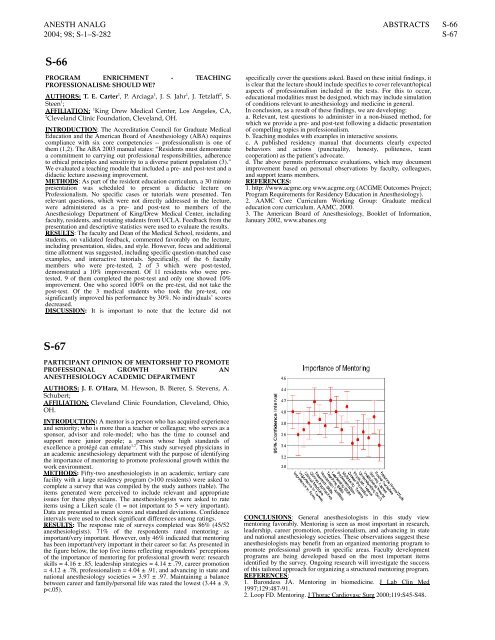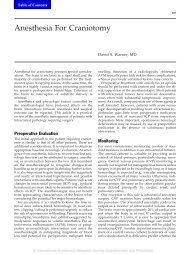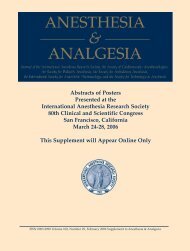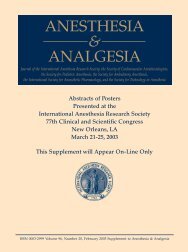ANESTHESIA & ANALGESIA - IARS
ANESTHESIA & ANALGESIA - IARS
ANESTHESIA & ANALGESIA - IARS
You also want an ePaper? Increase the reach of your titles
YUMPU automatically turns print PDFs into web optimized ePapers that Google loves.
ANESTH ANALG ABSTRACTS<br />
2004; 98; S-1–S-282<br />
S-66<br />
PROGRAM ENRICHMENT - TEACHING<br />
PROFESSIONALISM: SHOULD WE?<br />
AUTHORS: T. E. Carter 1 , P. Arciaga 1 , J. S. Jahr 1 , J. Tetzlaff 2 , S.<br />
Steen 1 ;<br />
AFFILIATION: 1King Drew Medical Center, Los Angeles, CA,<br />
2<br />
Cleveland Clinic Foundation, Cleveland, OH.<br />
INTRODUCTION: The Accreditation Council for Graduate Medical<br />
Education and the American Board of Anesthesiology (ABA) requires<br />
compliance with six core competencies -- professionalism is one of<br />
them (1,2). The ABA 2003 manual states: “Residents must demonstrate<br />
a commitment to carrying out professional responsibilities, adherence<br />
to ethical principles and sensitivity to a diverse patient population (3)."<br />
We evaluated a teaching module that included a pre- and post-test and a<br />
didactic lecture assessing improvement.<br />
METHODS: As part of the resident education curriculum, a 30 minute<br />
presentation was scheduled to present a didactic lecture on<br />
Professionalism. No specific cases or tutorials were presented. Ten<br />
relevant questions, which were not directly addressed in the lecture,<br />
were administered as a pre- and post-test to members of the<br />
Anesthesiology Department of King/Drew Medical Center, including<br />
faculty, residents, and rotating students from UCLA. Feedback from the<br />
presentation and descriptive statistics were used to evaluate the results.<br />
RESULTS: The faculty and Dean of the Medical School, residents, and<br />
students, on validated feedback, commented favorably on the lecture,<br />
including presentation, slides, and style. However, focus and additional<br />
time allotment was suggested, including specific question-matched case<br />
examples, and interactive tutorials. Specifically, of the 6 faculty<br />
members who were pre-tested, 2 of 3 which were post-tested,<br />
demonstrated a 10% improvement. Of 11 residents who were pretested,<br />
9 of them completed the post-test and only one showed 10%<br />
improvement. One who scored 100% on the pre-test, did not take the<br />
post-test. Of the 3 medical students who took the pre-test, one<br />
significantly improved his performance by 30%. No individuals’ scores<br />
decreased.<br />
DISCUSSION: It is important to note that the lecture did not<br />
S-67<br />
PARTICIPANT OPINION OF MENTORSHIP TO PROMOTE<br />
PROFESSIONAL GROWTH WITHIN AN<br />
ANESTHESIOLOGY ACADEMIC DEPARTMENT<br />
AUTHORS: J. F. O'Hara, M. Hewson, B. Bierer, S. Stevens, A.<br />
Schubert;<br />
AFFILIATION: Cleveland Clinic Foundation, Cleveland, Ohio,<br />
OH.<br />
INTRODUCTION: A mentor is a person who has acquired experience<br />
and seniority; who is more than a teacher or colleague; who serves as a<br />
sponsor, advisor and role-model; who has the time to counsel and<br />
support more junior people; a person whose high standards of<br />
excellence a protégé can emulate 1,2 . This study surveyed physicians in<br />
an academic anesthesiology department with the purpose of identifying<br />
the importance of mentoring to promote professional growth within the<br />
work environment.<br />
METHODS: Fifty-two anesthesiologists in an academic, tertiary care<br />
facility with a large residency program (>100 residents) were asked to<br />
complete a survey that was compiled by the study authors (table). The<br />
items generated were perceived to include relevant and appropriate<br />
issues for these physicians. The anesthesiologists were asked to rate<br />
items using a Likert scale (1 = not important to 5 = very important).<br />
Data are presented as mean scores and standard deviations. Confidence<br />
intervals were used to check significant differences among ratings.<br />
RESULTS: The response rate of surveys completed was 86% (45/52<br />
anesthesiologists). 71% of the respondents rated mentoring as<br />
important/very important. However, only 46% indicated that mentoring<br />
has been important/very important in their career so far. As presented in<br />
the figure below, the top five items reflecting respondents’ perceptions<br />
of the importance of mentoring for professional growth were: research<br />
skills = 4.16 ± .85, leadership strategies = 4.14 ± .79, career promotion<br />
= 4.12 ± .78, professionalism = 4.04 ± .91, and advancing in state and<br />
national anesthesiology societies = 3.97 ± .97. Maintaining a balance<br />
between career and family/personal life was rated the lowest (3.44 ± .9,<br />
p





